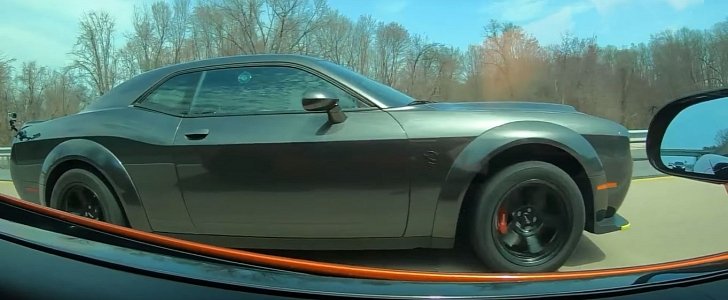When Dodge announced that the Demon would play the quarter-mile game in 9.65 seconds, many rushed to the conclusion that SRT's new halo car would be unbeatable on the street. Nevertheless, the real-life battles that have taken place recently don't exactly support that assumption. And we're here to show you a fresh adventure of the sort, one that saw the uber-Challenger duking it out with a McLaren 570S.
Now, before we dig any further into this matter, allow us to remind you of a now-famous street race adventure that saw a Dodge Demon battling a Tesla Model S P100D. It all started with the Demon failing to hook at up to 90 mph after its driver had... shaved the Hoosier racing slicks he had installed by pulling a massive burnout.
The Demon owner placed the factory Nitto drag radials back on the car and a rematch followed. In between the two battles, the Demon also fought a McLaren 720S, with the muscle car getting trampled by the supercar.
Then again, the 570S is considerably slower than the 720S and there are at least two reasons for that. First of all, we're looking at two different sub-ranges (the 570S is a Sports Series, while the 720S is a Super Series Macca). Then there's the generation gap between the two.
We need to mention that both the McLaren 570S and the Dodge Demon we have here came in stock form. As far as the Challenger is concerned, this means that car packed the standard 808 hp ECU (as opposed to the 840 hp race gas ECU), as well as the non-skinny front tires, while all the seats were in the vehicle.
The two velocity tools duked it out on the street, battling on two separate occasions. And while both races involved rolling starts (the McLaren driver thus cut the Demon guy some slack), the first took place at 50 MPH, while the latter involved a 30 MPH takeoff. And you'll find the results at the 14:10 point of the clip below.
The Demon owner placed the factory Nitto drag radials back on the car and a rematch followed. In between the two battles, the Demon also fought a McLaren 720S, with the muscle car getting trampled by the supercar.
Then again, the 570S is considerably slower than the 720S and there are at least two reasons for that. First of all, we're looking at two different sub-ranges (the 570S is a Sports Series, while the 720S is a Super Series Macca). Then there's the generation gap between the two.
We need to mention that both the McLaren 570S and the Dodge Demon we have here came in stock form. As far as the Challenger is concerned, this means that car packed the standard 808 hp ECU (as opposed to the 840 hp race gas ECU), as well as the non-skinny front tires, while all the seats were in the vehicle.
The two velocity tools duked it out on the street, battling on two separate occasions. And while both races involved rolling starts (the McLaren driver thus cut the Demon guy some slack), the first took place at 50 MPH, while the latter involved a 30 MPH takeoff. And you'll find the results at the 14:10 point of the clip below.





